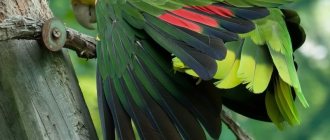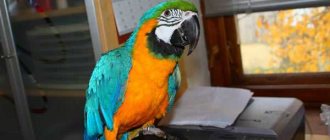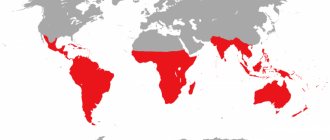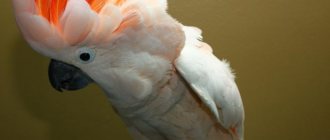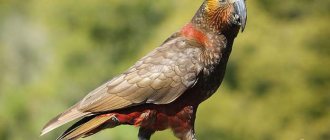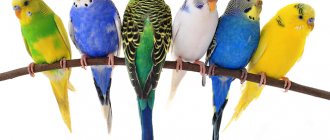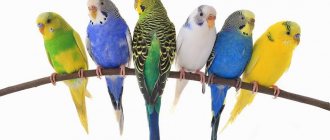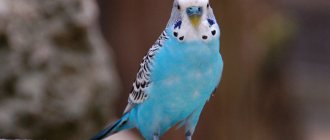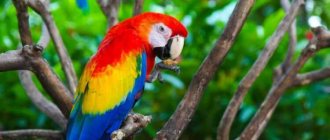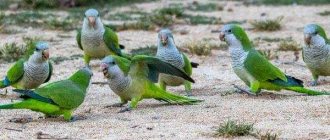Budgerigar
Noisy and restless birds inhabit almost the entire mainland and the nearest islands. Hardy and nimble wavyfish move in large flocks, from one dozen to several hundred. This is the most numerous Australian parrot. They prefer semi-deserts and steppes; they are not frequent guests in dense forests.
Taking off quickly, they are able to cover considerable distances in search of food. Grassy plains become a temporary refuge, where they feed on grass seeds. They feed mainly on fruit pulp, the center of seeds and nuts. Thirst is quenched on the fly, because many birds of prey are not averse to feasting on them.
They spend most of their lives in trees, sheltered from the heat and enemies. The future offspring calmly waits for birth here, in the hollows. They sleep up to 12 hours a day. In natural habitats, only green colors are found:
- weigh up to 40 g;
- grow 18 cm in length;
- live up to 20 years.
The ability to imitate human speech has turned budgies into beloved pets.
Gallery
File:Nymphicus hollandicus - perched on wires - Australian parrots of Australia-6a.jpg|Wild
File:Cockatiel Crest jpg|A wild type (natural grey) Australian parrot showing excitement or interest with its mounted crest
File:Tiel kiss png|Male Australian parrots
File:Parrot Australian parrot lutino.4months.jpg|A pet lutino Australian parrot on hand of his companion
File:Nymphicus hollandicus - favorite ADMpied.jpg|A young favorite Australian parrot ADMpied
File:Captive .jpg|Nearly-all clear (notice the small gray feathers near the edge of its wing), ADMpied Australian parrot
File:Whiteface Australian parrot lutino whiteface chick.jpg|Three-week-old lutino Australian parrot chick
File:PictureofSnowy2 .jpg|One-day-old Australian parrot squeaks
File:Cockatiel under the plumage of invisible light jpg|Cockatiel blazing under the invisible light
File:Cockatiels .jpg|Cockatiels are social birds
File:Male Australian parrot jpg|Male gray Australian parrot
File:Female Australian parrot. JPG|Female gray Australian parrot
File:Katrina and Bloo Cockatiels.png|Three-year domestication of Australian parrots
Corella
They live in arid regions and steppe zones of the continent, preferring grassy carpets and shrubs, as well as eucalyptus groves. They live in small groups of 10-60 birds. Huge accumulations can only be observed during droughts, along lakes and rivers.
Australian parrots feed on fruits and nectar of flowering eucalyptus, and are rarely content with midges and small insects. To quench their thirst they sit on the water. They scream so much that sometimes you can confuse them with a wild animal. And this is with very modest dimensions:
- 150 g at 30 cm;
- live up to 30 years.
Lifestyle in natural conditions
Eucalyptus forests in the south and west of Australia, shrubby heaths, and woodlands are the favorite habitat of the Inca cockatoo. They prefer to inhabit arid areas, and there must be a body of water nearby.
Sometimes they like to settle near farmland, surrounding gardens and fields and eating fruits, vegetables, and grains. These intelligent parrots are often a big problem for farmers.
In their natural environment, desert cockatoos eat a varied diet:
- fruits from trees, vegetables and fruits,
- cereals,
- flowers and buds,
- berries,
- tree leaves,
- roots,
- cones,
- nuts,
- plant seeds,
- as well as insects and their larvae.
Parrots prefer to stay in pairs or small groups. Their main pastime is searching for food. They are active in the morning and evening hours - especially when they go to water. During other hours they prefer to rest in the treetops.
A pair of cockatoos often occupy a considerable territory - up to 500 hectares - and jealously guard their feeding grounds from the encroachments of competitors.
The life expectancy of an Inca in the wild is 50 years; in captivity, these birds can live much longer. There is evidence of a long-lived species of this species, living up to 83 years.
King parrot
Australian birds received this name for their regal plumage and independent character. In males, the head, neck and chest are colored red, in females - green. They settled on a narrow strip of land along the Pacific coast in dense tropical thickets.
Mobile parrots roam in small groups and even pairs. They fly well and move gracefully through trees, hiding away from people. However, they are excellent at taming in captivity, but are not at all able to copy the speech of the owner.
In nature, they are saturated with flowers, fruits, buds and young shoots of plants, seeds and insect larvae. Quite large individuals weighing almost 2 kg, the body reaches half a meter. King parrots live for 25 years.
Sexual dimorphism
All wild Australian parrot chicks and juveniles appear female, and are virtually indistinguishable from the time of hatching until their first molt. They display horizontal yellow stripes or bars on the ventral surface of their tail feathers, yellow spots on the ventral surface of the primary flight feathers on their wings, a gray crest and face, and a dull orange patch on each of their cheeks.
Adult Australian parrots are sexually dimorphic, although to a lesser extent than many other avian species. This is only evident after the first molt, typically occurring about six to nine months after hatching: the male loses the white or yellow ban and spots on the underside of his tail feathers and wings. The gray feathers on his cheeks and crest are replaced with bright yellow feathers, while the orange cheek patch becomes brighter and more distinct. A woman's face and comb will typically remain mostly gray, although orange cheek is also corrected. In addition, the female usually retains a horizontal bar on the underside of her tail feathers.
Color in Australian parrots is derived from two pigments: melanin (which provides the gray color in the feathers, eyes, beak and legs), and lipochromes (which provide the yellow color on the face and tail and the orange color of the cheek patch). The gray color of melanin overrides the yellow and orange color of lipochromes when both are present.
Melanin content decreases in the face of males as they mature, allowing yellow-orange lipochromes to be more visible, while an increase in melanin content in the tail causes the horizontal yellow bars of the tail to disappear.
In addition to these visible characteristics, the vocalizations of adult males are typically louder and more complex than that of females.
Cockatoo
Very smart birds. They are able to remember not only several dozen words and phrases, but also imitate pets and surrounding sounds. These Australian parrots fly ineptly. For most of their life, and their life is not short, they nimbly climb trees and move along the ground. The average age of Australian cockatoos is 80 years. They are found both on the continent itself and in New Guinea, the Philippines and Indonesia.
A powerful, “bucket-like” beak with sharp serrations is a good tool for climbing and a formidable tool for nutshells. They eat insects and their young, semi-ripe seeds and grains of plants, berries and fruits.
The cockatoo boasts not only an exceptional appearance with elongated feathers on the forehead and head, but also impressive parameters.
- On average, depending on the species, birds grow up to 30 cm. Some individuals are quite large - up to 70 cm.
- Accordingly, the weight ranges from 300 to 1200g.
Reproduction
The cockatoo bird reaches sexual maturity late. She acquires the ability to procreate no earlier than 3 years of age. Such late maturation is associated with developed skills in raising young animals.
The female and male cockatoos form a long-term monogamous relationship and remain faithful to each other for a long time. These birds form pairs while still growing up, so they have virtually no mating rituals. To breed chicks, cockatoo parrots choose ready-made hollows or nests that are located near sources of food and water. Inside they line them with leaves and tree bark.
Before mating, the male settles down next to his companion, spreads his crest and begins to smoothly shake his head. As soon as the female pays attention to him, the birds begin to sort through each other’s plumage. This ritual is followed by the mating process.
After some time, the female lays a clutch of 1-7 eggs, the sizes of which vary between 19-55 mm. The number of eggs depends on:
- from the variety (brown-headed, black and Banks' cockatoos lay 1 piece each, cockatiel - 3-7 each, the rest 2-3);
- size (the larger the parrot, the fewer eggs in the clutch);
- availability of food (the more food, the more numerous the clutch).
The female incubates the eggs for 20-33 days. Chicks of almost all species have a light yellowish fluff from birth. And only black parrots hatch completely hairless.
After 7 days, the babies' eyes open, and after another 4 weeks they begin to fly. At about 3 months of age, the chicks become acquainted with their flock and try adult food. Despite their relative independence, the young remain under the supervision of their parents for a long time and get out of control after about a year.
Rosella
They feel comfortable in close proximity to a person. They often live in parks and squares along the river of small reservoirs; in captivity they quickly become attached to the owner. In nature, they settle in the steppe expanses and savannas of the small continent.
They move in small groups of 50 individuals and prefer to cover short distances. These are the only parrots in Australia whose entire body is covered with feathers of amazing beauty.
Origin story
This species of parrot has a long history, and the homeland of cockatoos is Australia. After all, it was in the northern part of the mainland in Riversleigh Park that the most ancient remains of similar birds were discovered. As a result of studying their mitochondrial genomes, a team of molecular biologists came to the conclusion that the dissociation of the genus from other psittacids occurred about 28 million years ago. Another group of experts adheres to the version that this happened after the split of the ancestors of modern kakapos and Nesters.
The first attempt to classify cockatoos was made in 1740 by a scientist named Mathurin-Jacques Brisson. In his scientific work “Ornithology”, the Frenchman designated a new genus Cacatua and assigned 5 species to it. Subsequently, the list was supplemented with 16 more species.
Red-winged parrot
Rarely gets along in captivity. Under natural conditions, they settle at an altitude of 500-600 meters in acacia thickets and mangrove forests. This is the least studied species of Australian parrots. They live in small colonies, up to 15 individuals, on the territory of New Guinea. Small birds, weighing 210g, live up to 25-27 years.
If you liked the article or have something to add, leave your comments and also join our VKontakte group.
Character and abilities
Lovebirds
The Necklace Parakeet is distinguished by its good-natured character, sociability, cheerful disposition and excellent ability to get along with people.
The bird is curious, which often makes it do all sorts of tricks, for example, it can chew through an electrical wire, cage bars, gnaw furniture or books, and even drag something interesting for itself into the cage.
Ring-necked parakeets love toys; they are especially attracted by a small mirror, which must be hung within their reach. They will enthusiastically look at their reflection for hours.
But what ringed pets do not like is the proximity to other birds, especially if they are of the same sex, smaller and weaker than them. The bird immediately tries to take a dominant position and does not let its neighbor near food, water, or toys. Therefore, co-location in an aviary is only permissible for several similar-sized necklace parrots or even larger individuals of other species.
Azure grass (turquoise) parakeet
Due to its green color and constant running on the ground, the parrot received this name. There are 7 varieties of them in nature. They are critically endangered and protected by government law. They live in Australia, in its forest and steppe parts. In search of food, they constantly run on the ground, only sometimes flying from place to place. The main thing in their diet is grain and plant seeds, sometimes berries and insects. They create pairs during the breeding season. This happens twice a year. The chicks hatch in hollows after three weeks. After 30 days they leave their nest and parents.
Australia is home to countless parrots. Some of them are on the verge of extinction. These amazingly beautiful birds are very popular and bring joy to their owners.
Lovebirds
The homeland of lovebirds is Africa. Also, some species of this genus can be found on Madagascar and other islands located near the African continent. Different types of lovebirds prefer to settle in different biotopes: subtropical and tropical forests, mountains or steppes. Birds like to stay near bodies of water; sometimes they can be seen near human habitation. Lovebirds lead a gregarious lifestyle. At night, flocks of parrots rest in trees, sitting on branches, and during the day they go in search of food. Lovebirds nest in tree hollows. At the bottom of the hollow, the female builds a nest from grass, twigs and pieces of bark.
Things you should know
It is very important that your parrot's cage always has two feeders and a drinking fountain, at least for those who can access them without any problems. We will examine water bowls and feeders to ensure that the water is clean and food is plentiful.
You should check regularly as parrots (like other birds) tend to shell the seeds on top of the food itself, creating a layer of important husks.
We will look at water bowls and feeders making sure the water is clean and food is plentiful. You should check regularly as parrots (like other birds) tend to shell the seeds on top of the food itself, creating a layer of important hulls.
This can give us the feeling that the trough is full, when the reality is that it represents an accumulation that cannot be transferred. For the same reason, seeds on the surface of the feeders should be blown out frequently, at least once a day.
I advise you to do this with soda straws so that they fly away but do not stick to our face or hair, once we catch the trick we will realize that it is very simple. However, we will always find seeds in our parrot's soil!
If you want to try the breed of parakeet, if the cage is not very large, a removable nesting box is usually placed next to the door for sale in specialized establishments. Additional observations to prepare the perfect home for our parrot:
At the bottom of the cage, to make cleaning easier, you can Place Gritt (mineral deposit) or running gravel.
bath for parrots It will be placed regularly so that they can enjoy the bath and clean their feathers. This helps them prevent ticks. When our friends have taken the shampoo, we will remove it, we should not leave it as a permanent element, they can defecate and drink at the same time.
It is always convenient for parrots to have at their disposal a cuttlefish bone or a salt tablet that performs the same function. In addition to providing calcium, it helps them avoid excessive beak growth.
There are also assistive devices located outside the cage so that they can regularly consume fresh food in a more hygienic way. Some products we can offer daily:
If you want to read more articles similar to Types of Cages for Parrots, we recommend that you enter the What You Need to Know section.
Domestication
Following George Shaw, zoologist John Gould conducted a detailed study of the lifestyle of budgerigars in 1837. He compiled the most accurate description of this bird species through careful observation. Modern scientists have still not been able to add new information to the characteristics of a zoologist.
As part of Gould's work, budgerigars were brought to Europe, where they instantly became wildly popular. At that time, only wealthy people could afford to own a strange bird, but this did not affect the high demand. Birds were exported in large quantities from their native country, and due to improper care, the parrots died on the way. At the same time, demand did not subside, so the overall population of parrots was under threat of destruction. Australian authorities soon banned the capture and export of wild birds from the country, offering domesticated birds to Europeans.
Instead of catching parrots, ornithologists began breeding offspring at home. The first successful attempt was in 1855. Jules Delon played a major role in this difficult matter, creating a detailed guide to caring for the strange bird.
When purchasing a budgie, it is advisable for the future owner to know about the characteristics of the birds’ habitat in the wild. In their natural environment, birds fly long distances every day, so birds should not be in a cramped cage. Wavys get along well in large flocks and create monogamous families.
Do you know interesting facts about the life of budgies in the wild? Leave comments and share the article on social networks!
Bluewings (Neophema chrysostoma)
Blue-winged Parrots have a body length of 21-22 cm, a tail of 10 cm, and a weight of about 35-55 grams.
The plumage of blue-winged parrots is dominated by olive green, but the coverts are a rich blue. The parrot has a blue stripe on its forehead. The belly is usually yellow, sometimes with a reddish tint. The tail is light yellow.
In nature, they prefer to live in open spaces and are found in savannas, meadows, fields, gardens and even swamps. Food is found on the ground. They feed on blades of grass and seeds of wild plants, and sometimes they can snack on insects.
Blue-winged parrots breed on the island. Tasmania, migrating along Bass Strait. Then they return to the mainland, where they spend the winter.
Parrots
And, of course, one cannot fail to mention Australian parrots in all their diversity and diversity. Here are just a few of the names of these birds with photos and brief descriptions.
Noble Parrot (Electrus)
The females of this subfamily are so different from the males that for some time they were considered different species. “Girls” sport red plumage, and “boys” wear bright green with a slight yellow on the head and red feathers in the wings. The light shine of this plumage makes them even more noble and attractive. These are quite large birds, up to 45 cm in length and up to 0.4 kg in body weight. They live up to half a century, but adapt well when kept at home, have a calm character, are tamed and are even able to “talk” a little.
King and parakeet parrots
Both varieties are common in the Australian wild and do well in captivity, although they are among the most expensive birds on the market. The male king parrot is especially striking with his black mantle and crimson wing feathers. The color of the short-winged variety is predominantly red. During the mating season, the male becomes aggressive and can show cruelty towards his chosen one, which goes away from the moment the eggs are laid, but can resume in relation to the chicks.
Cockatoo
This family includes two dozen species, plus the famous Corella. Even parrot lovers do not know all of these species due to the current law in Australia prohibiting the export of these amazing birds. Thanks to this, many of them were saved from complete extinction. A characteristic distinguishing feature of all types of cockatoos is a bright and large crest, which the bird can straighten, and a wide mandible. Due to the resemblance of the beak to the nippers, the bird got its name (Austrian “cacatua”). Not all of these species are domesticated; a striking example of this is the black cockatoo.
Tips for your Australian parrot to live longer
As we say, how long does an Australian parrot live depends on the attention and care given to it at home. The most important factors to consider are:
Don't let them breed too often
Eating young often involves the wear and tear of the parents. This affects his health and stamina. The Australian parrot sheds its feathers twice a year or three at most. But sometimes what is known as “continuous shedding” happens to them. The main reason is stress and constant plucking ends up wearing the animal emotionally. If continuous shedding is detected, it is important to seek medical attention as soon as possible. veterinarian Even in normal conditions of molting plumage, during these times it is advisable to strengthen your diet with vitamins.
Monitor your parrot's health. The two most common problems are the presence of mites or lice can be a serious problem if they are not addressed. Offer your parrot a good living environment: away from loud or stressful noises, at the right temperature and lighting
This is quality of life! You will avoid stress and therefore will live longer and better. Give this one adequate and quality food to provide you with all the vitamins and minerals you need for development. Always have help and advice from a specialized exotic animal veterinarian.
It's not very difficult! It's about giving your new friend the best of you. We are confident that this will make you happy for a long time.
